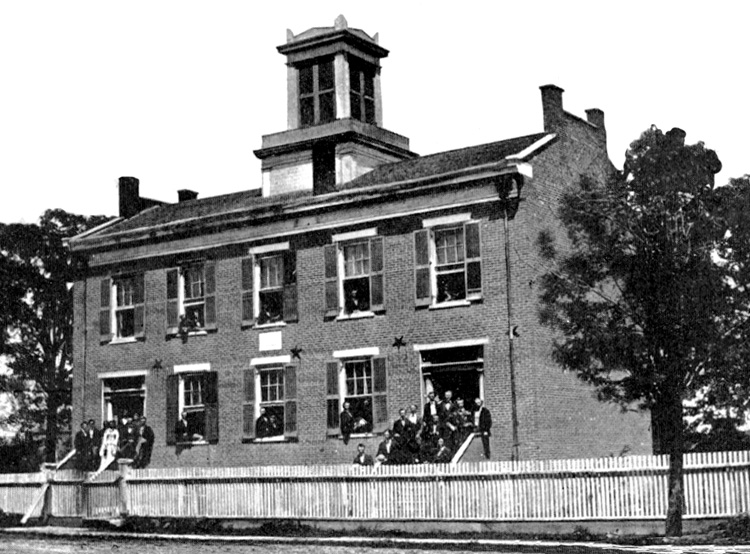
Early
University of Iowa students and faculty pose on the steps of UI’s first home
– the historic 1842 Mechanics Academy,
which was located along the east face of Linn Street just north of Iowa Avenue, a section of street now beneath UI’s Seashore Hall.
|
By
Bob Hibbs A
non-existing two-story brick Mechanics Academy building surely ranks second
only to Old Capitol in historic significance to Iowa City and the University
of Iowa. Despite
beginning life in 1842 as a school endeavor which would soon fail, it would be
difficult to overstate its importance as the site of important local events.
It was the nursery for many of the most important institutions and
organizations in Iowa City today. Among them: ·
First Iowa City public school
class met within its walls in 1853. ·
University of Iowa offered its
first classes there in 1855. ·
University Library was founded
there in 1855 with 50 books in a closet. ·
Iowa’s first teacher
training was provided there in 1860. It’s now the University of Northern
Iowa. ·
Purchased by UI in 1866 as its
second dormitory; South Hall was first in 1862. ·
Converted into the first
teaching hospital for UI’s College of Medicine in 1872. ·
Nursery to Iowa City’s Mercy
Hospital, founded there in 1872. ·
Home to the first UI bell, now
stored at UI’s sports Hall of Fame. This bell never hung in Old Cap, rather
it began in 1845 in a failed Presbyterian Church belfry along Burlington
Street. ·
First home of State Historical
Society of Iowa outside Old Capitol. ·
The nursery and temporary home
during the 1840s to numerous local churches and clubs. It
was created by the Mechanics’ Mutual Aid Association of Iowa City, formed in
1841 to promote “advancement of the mechanical arts; and whatever may tend
to the promotion of education, and the advancement of the arts and
sciences.” Some
40 members elected James Ball president, and Thomas Comb and Louis Swafford
vice presidents. Before automotive “mechanics” redefined it, the word
applied to carpenters, brick masons and related crafts. During
its first session in Iowa City – meeting in a two-story wood-framed
temporary legislative hall called Butler’s Capitol in deference to its
hotelier owner, Walter Butler – the territorial legislature incorporated the
association and donated a site, subject to erection an edifice worth at least
$1,000 within two years. A
“school” reserve on the original plat of Iowa City comprised a block-long
by half-a-block-deep acre-sized site forming the east face of Linn Street
between Iowa Avenue and Jefferson, a section of street now closed. During
spring 1842, President Ball cut stones and built a foundation, association
member and pioneer brick-maker Sylvanus Johnson provided bricks, carpenter
Swafford made window frames from lumber cut by Henry Felkner’s mill.
Virtually everything, both materials and labor, was donated. The
30-foot by 60-foot building with full basement cost of less than $50 cash. It
was valued at $3,000 or more. About
200 attended a cornerstone ceremony June 24 amid pageantry which included a
parade along downtown streets. Private
classes ensured costing $1 a month for a three-month term, except more than $3
a month for “music on the piano.” August 1843 enrollment reached 105,
including 62 girls. The association realized a $73 profit that term. But
staffing difficulties unraveled the enterprise. Soon other groups were renting
the building, including the Masons and Odd Fellows the entire top floor. With
organization of city government in 1853, the schools committee of the council
rented the building for $230 a year. The
building served numerous ways until demolition in 1897 for a new University
Hospitals, which sat in part on Linn Street right-of-way and faced Iowa
Avenue. The
cornerstone currently resides in the east vestibule of UI Medical
Laboratories, moved west of the river with the rest of U-Hospitals during the
1920s. It
awaits a more appropriate home in a new outdoor kiosk along Iowa Avenue near
the statue of Irving Weber at the Linn Street intersection. Project, anyone? Next
Saturday:
Archie Alexander: football standout and local builder. Bob Hibbs collects local postcards and other historic ephemera and researches history related to them.
|